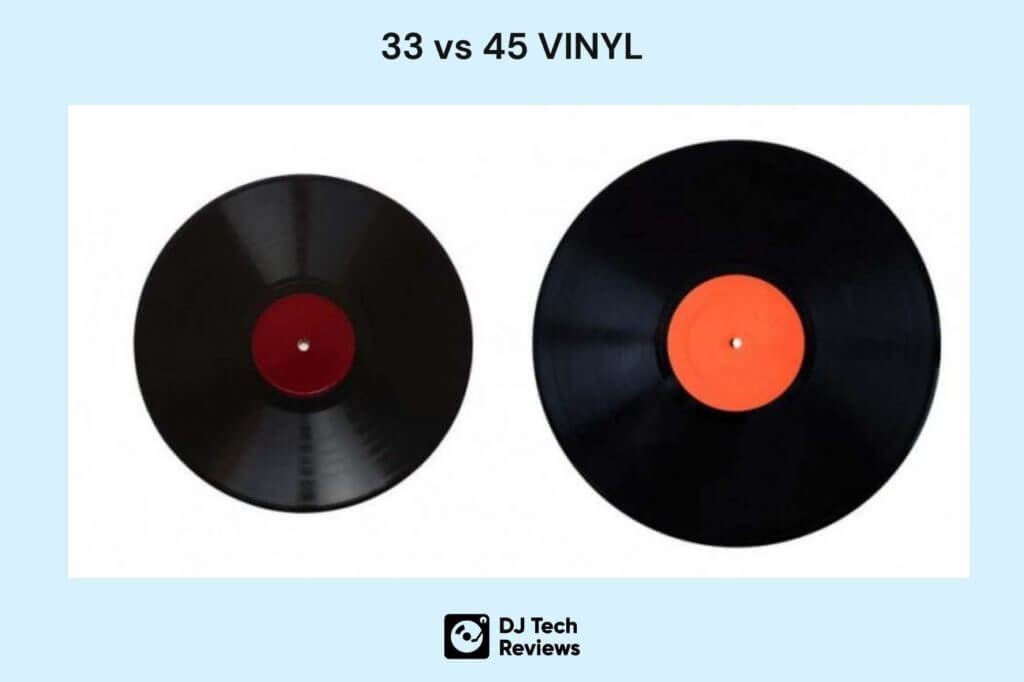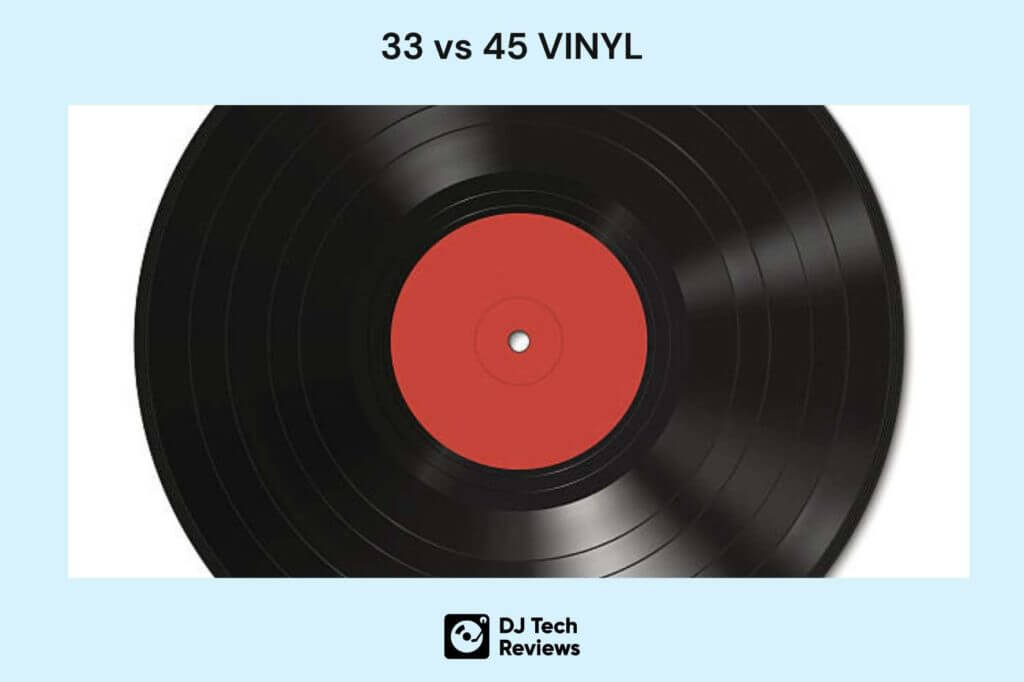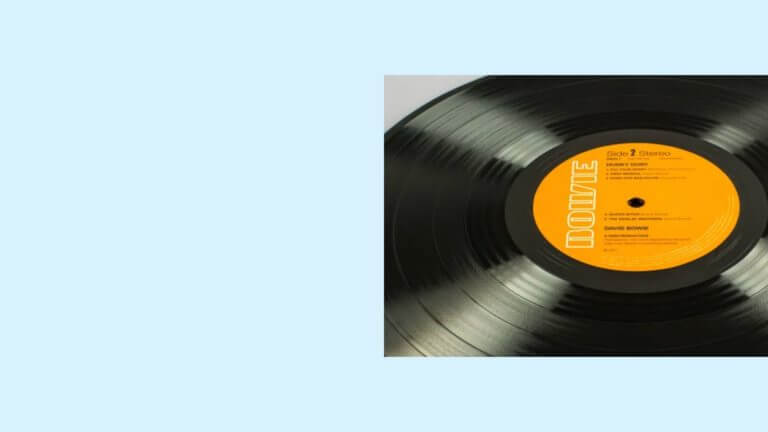Here we clarify the age-old 33 vs 45 vinyl RPM difference conversation.
Vinyl records, arguably more so than the turntable, have been virtually synonymous with the DJ world. Since its inception, vinyl has been a mainstay throughout the DJ world.
Now, many years later, while they are no longer an essential part of the DJ experience, many performers still opt for the feel of scratching and mixing using real vinyl records.
If you are new to the DJ world or haven’t yet tried DJing with vinyl records, you may be unaware of some of the different aspects that make up record sizes or how they operate on a DJ’s turntable. Things like a record’s size and speed all play a huge factor.
As such, you must determine the difference between the records as quickly as possible so that you don’t end up with the wrong record for your performance. This is especially true when it comes to selecting the record with the right RPM.
But which RPM is right for you? For most turntable DJ devices, they will run either a record at 33 or 45 RPM. While most turntables that can accept one can accept the other, the settings and how they interact during a performance can be pretty different. In this guide, we’ll go over how you can easily know the difference between a 33 or 45 RPM record as well as go over the different existing vinyl record options before deciding which of the two is better.
33 vs 45 Vinyl (in short)
The 45 RPM record size version is far more popular with DJs. This is because 45s travel faster than the 33 record size format. They are larger thus allowing for more waveforms to be squeezed into the format. More space givrs 45 more bumps and grooves which equates to a superior audio quality.

RELATED ARTICLE: How Much Does A Vinyl Record Weigh? (Exactly)
Factor #1. The Size
Firstly, before anything else, you’ll want to check out the record’s respective size. Generally, 12-inch vinyl records run at 33 RPM while records that are 7 inches operate at 45 RPM. This can easily be found via the central label.
This isn’t a perfect method, however. If you have a record that is a 12-inch single, as opposed to an LP, the speed is more than likely going to run at 45 RPM.
RPM’s Connection With Record Size
Below is a brief overview of the different record sizes and how they operate at different speeds, as well as their current production circulation.
7-inch Vinyl Records
- At 45 RPM: 7-inch records at a 45 RPM speed are incredibly common and are the standard go-to when it comes to 45 RPM records
- At 33 RPM: 7-inch records at 33 RPM are much less common when compared to those at 45 RPM. These are rarely in circulation and are very rare to find.
10-inch Vinyl Records
- At 78 RPM: 10-inch records are innately rare. This is because 10-inch records aren’t even produced anymore, most production companies instead of going to 7 and 12-inch record sizes. These are generally much thicker records and technically aren’t even made from vinyl, instead of being made from shellac.
12-inch Vinyl Records
- At 45 RPM: 12-inch records, while more prevalent than 7-inch 33 RPM records are much less common than the standard records. The produced options are almost always going to be singles over anything else and are known as being largely promotional while having a higher sound quality.
- At 33 RPM: 12-inch records at 33 RPM are much more common than every other combination except 7-inch 45 RPM records. Between the two, they are the most widely produced and circulated type of record, and is why both are regarded as the primary record size and RPMs

Factor #2. Track Density
After record size, the second way you can know the RPM speed of a record is based on the number of tracks per face.
Particularly useful in determining the RPM of 12-inch records, if a record has over 3 tracks per face, it is highly likely to have 33 RPM. Conversely, records with no more than 2 tracks are much more likely to have a 45 RPM.
The best way to immediately, and at a glance, tell a record’s RPM is by looking at the number of tracks on its face, based on the number of spaces between the grooves. A six-tracked record is likely to have 33 RPM.
33 vs. 45 RPM – Which Record Size Is Better?
While both, the 33 and the 45 RPM record sizes have their respective pros and cons, there is a clear winner between the two.
Below, we’ll go over some of the different categories that make up a higher quality record before coming to a verdict over which option you should be more interested in.
#1. Sound Quality – 45 RPM
The first and most important factor you should be on the lookout for, in the majority of instances, you’ll find that the 45 RPM record sounds better than the 33 RPM record. As the 45 RPM record moves at a higher speed, more information can travel per second. This results in an increased amount of details when compared to the 33 RPM option. It also often results in more detail being uncovered.
#2. Longevity – 45 RPM
Following sound quality is speed. Here again, the 45 RPM is a clear winner. Because of its higher speed, 45 RPM records can reduce the ongoing record degradation that happens.
As there is less being traveled per rotation, this means that fewer grooves are being affected per second. As sound quality steadily decreases inward for records, faster RPM records can stay out further for longer, making them the preferred option.
And The Runaway Winner is…45 RPM
As you can see, at least when it comes to the record’s sound quality and overall longevity, the 45 RPM option is the clear winner.
However, there are other factors that one must consider specific to their situation.
For example, some areas that can potentially lead to 33 RPM having a higher sound quality can include the overall mastering, the quality of the vinyl pressing factory, or even access to the original tape.
As it stands, while 45 RPM records are considered superior to 33 RPM records at least 80% of the time, there are particular times where the 33 RPM may be better.

RELATED ARTICLE: Do DJs Still Use Vinyl? (in 2022?)
33 v 45 RPM: Takeaway
We finish with our 33 v 45 RPM takeaway.
Knowing what makes a vinyl record 33 or 45 RPM is very important for any starting DJ who wishes to one day use a turntable. More so, just as it is important to know which is which, it is also important to know which is better.
By understanding what you are looking for with record sizes and how important you want the sound quality to be, you are setting yourself up to do a little bit better in your DJ career.




